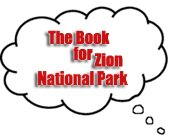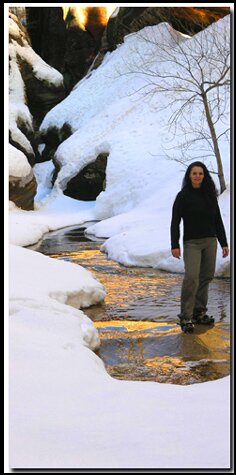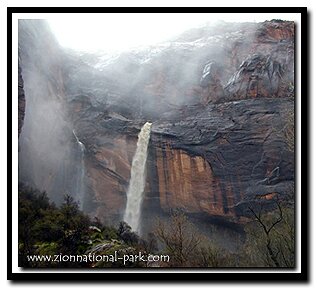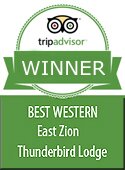
|
||||
|
Zion National Park Lodging Park Info Vacation Weather Photos Hike SR-9 Slots Backpack Camping |
||||
Winter in Zion National Park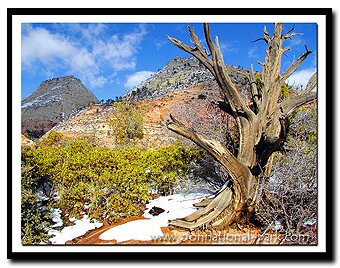
Winters in Zion are mild, allowing hikers to experience many of the parks trails year-round. Some of the paths that get little sun might be icy, so check with the Zion Canyon Visitor Center before heading out. Use common sense and turn back if trail conditions are unsafe. Crampons or yak-traks are used by many who like to hike in the winter. Zion's Winter Road Conditions The main road through the park known as the Zion-Mt. Carmel Highway is always open, but there are restrictions for large vehicles such as RV's and tour busses. If you are driving through the park during a snow storm, a 4WD is recommended. The roads are plowed and sand is put down, but like travel through any snowy area it can be dangerous and icy. The Zion Canyon Shuttle does not run in Zion Canyon from mid-November to mid-March, but this is a wonderful time since you may drive your private vehicle into the canyon during these few months of the year.
Winter Photography - The east side of the park is a winter photographer's dream where swirls of red rock meander with pockets of brilliant white snow along the Zion-Mt. Carmel Highway (SR-9). Swelling storms fill blue skies with puffs of gray clouds, providing an ideal backdrop for dramatic winter photography and trees hold their leaves year-round allowing for wonderful photo opportunities. In contrast, in Zion Canyon, along the Virgin River, leaves fall padding the ground and providing a very different winterscape to capture on film. The river is usually higher in the winter and there are waterfalls and mist that exist at no other time of the year. The winter photographer can capture a time in Zion when it is at its most beautiful and few are around to see it. 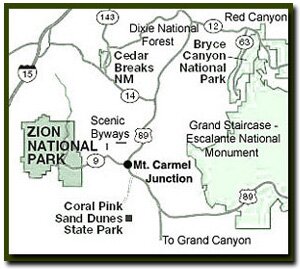
Winter Hiking - While many of the trails in Zion Canyon are open in the winter, they often have minor obstacles such as patches of snow, ice and mud. Some of the most popular trails in the park: Weeping Rock, Emerald Pools, Riverside Walk, Angels Landing, Hidden Canyon and Observation Point have areas that get little sun making them pleasant in the summer but icy in the winter. The Sand Bench Trail is used by horses in the summer but in the winter, when the operation shuts down, it becomes a pleasant hike. Other than the Canyon Overlook Trail, the east-side trails are not paved like many of the Zion Canyon trails making mud a factor in the winter. The East Rim can have deep snow so snowshoes or skis can be fun on it. The East Mesa and East Rim to Cable Mountain and Deertrap Mountain are all possible for the experienced snow hikers. Contact the Zion Canyon Visitor Center before hiking in the winter
The Chinle Trail is a low desert trail located outside the popular boundaries of the park near Rockville. Allow at least 8 hours of daylight to complete this 14.4-mile round-trip. Coalpits Wash runs along a low desert terrain. In fact, it is the lowest point in Zion National Park at an If the stream is flowing, Scoggins Wash is the most interesting of the southern trails. This one has a little bit of everything including some fun boulder-hopping toward the end. Scoggins Wash is a tributary of Coalpits that drains below the Altar of Sacrifice. Allow at least 8-hours of daylight to complete this 11-mile trail. Huber Wash is a short hike through a wash on the far south-side of the park. It is in the area of Scoggins, Chinle and Coalpits. Allow 3-hours for this 4-mile round-trip. Winter Canyoneering in Zion
Backcountry - Unlike Zion Canyon, the backcountry gets a good share of snow. The last snow usually falls around Easter. Zion's Winter Temperatures - Most of the winter the temperatures in Zion are suitable for short day hikes. Heavy snow is common at the higher elevations but the canyon at 4000 feet sees little snow and when it does it does not stay on the ground long.
Zion National Park, UtahHistory of the Thunderbird |
East Zion Lodge Mileage from Stay in a hotel the heart of the parks, Mount Carmel Junction, and visit the treasures of the Southwest and Utah. Site Map Zion Hiking
|
|||||||||||||||||||||||||||||||||||||||||||||||||
|
This is my new favorite quote:
"I don't know who Mary Cisneros is, but I mean zionnational-park.com It's a better site than the NPS's anyway." Written by the authors of the book: Favorite Hikes in and around Zion National Park |
||||||||||||||||||||||||||||||||||||||||||||||||||
|
Zion History |
|---|
All rights reserved © Copyright Zion National-Park dot com
Do not use text, photos or maps without permission © Zion National-Park dot com
Contact the Author Mary Cisneros with any errors

